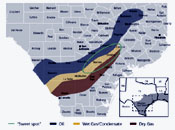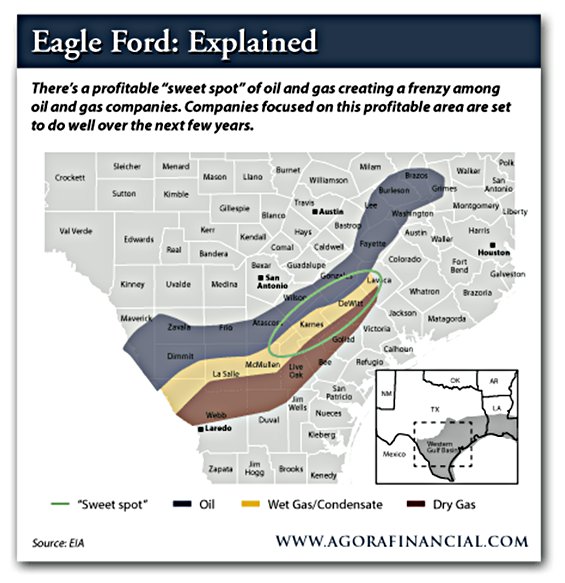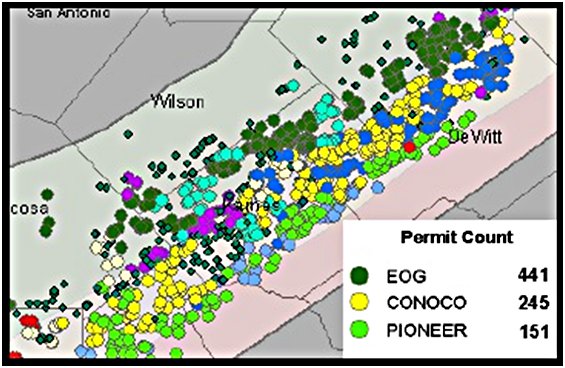
Discover. . .optimize. . .harvest. . .
When it comes to profiting from America's shale bounty, those are the only three words you need to know.
Today I want to show you why this three-part cycle is separating the treasure from the trash in the Eagle Ford. And more importantly, how you can use it to cash in. . .
Richard Mason, the chief technical director for Hart Energy, explained this three-step progression to the crowd at last week's Developing Unconventional Oil & Gas conference in San Antonio (just north of the Eagle Ford formation.)
You see, when it comes to America's new shale bounty, the cycle is evident.
First, shale players have to discover the deposit and delineate the sweet spots. In the early stages of this cycle costs are high and wells are hit or miss. It's a real wildcat atmosphere. But if you bet on the right pony in this race you can make a killing.
Next shale players optimize drill plans and completion strategies in order to lower costs and increase recovery. The optimization phase is where investors can narrow down their options and focus on the best players.
Last, shale players harvest their bounty of oil, gas and condensates. This is the stage where investors can expect continued production and respectable returns through dividend payments.
Today, the Eagle Ford has long been discovered, and the sweet spots are evident (I even circled them below!):

Thus, the Eagle Ford is in between the optimization phase and the harvest phase, ready to payout for investors.
A key theme at this year's DUG event in San Antonio was that moving from the optimization stage to the harvest stage can separate the winning investments from the losing ones.
From my viewpoint, the optimization and harvest phase is already showing the best Eagle Ford investments. So let's have a look. . .
When you look at the drill-permitting chart for the Eagle Ford, you'll start to see a pattern. First, everyone wants to be in the "sweet spot" of the play (unfortunately for latecomers, real estate in this neck of the woods is leased out!) But once you zoom in to that sweet spot, which is still about 70 miles long and nearly 20 miles wide, there's another noticeable trend amongst operators.

Source: DrillingInfo
This is a busy graphic to be sure, but if you look at it in three sections it's easy to unlock the code. In particular you can see that EOG Resources (EOG), ConocoPhillips (COP) and Pioneer Natural Resources (PXD), all hold parallel positions along the oil/gas window.
First look at EOG in the dark green. Then look to Conoco in the yellow. Last, look at Pioneer in the light green.
Specifically, you can see that three producers are concentrating their permits in a northwest line (and if you must know, the dark blue circles represent Talisman/Statoil and the purple circles represent Marathon permit activity. . .so those companies are also in the thick of things.)
The three operators listed on the map are essentially "going with the grain" of the Eagle Ford play. Considering we're in the midst of the optimization stage, this is no coincidence.
EOG is in a northwest line in the oil window, Conoco is in a northwest line in the oil/condensate window and Pioneer is in a northwest line in the condensate/gas window. By aligning themselves in this fashion, these companies are able to maximize their well plan standardization.
For example, EOG is focusing its efforts to efficiently produce oil. And by looking for a standardized play the company can start maximizing its well efficiency: standard drill plans, multi-well designs, standard completion techniques, standard downstream logistics, etc.
This is precisely what you'd want to see as an investor. Efficiencies are coming home to roost in South Texas.
But not all companies are aligning in such profitable form. Taking a look at another big player in the area, you'll see that Chesapeake Energy isn't taking the same optimized approach (which is also a reason I'm not adding them to the investment-worthy category right now.)
Whereas EOG, Conoco and Pioneer are aligning themselves with riflelike accuracy in the sweet spot of this formation, Chesapeake seems to be going for a shotgun method of permitting. It could work out for Chesapeake in the long run. But I'd much rather go with three horses taking the inside-track toward the finish line.
There are other reasons that prove now's the time to take a look at efficient operators in the Eagle Ford, too. One major theme covered at last week's DUG event was that prices for services and supplies are actually on the downswing.
Whereas last year the price for completion crews (guys that can hydraulically stimulate the wells and put them on production) was on the rise, right now the price is falling.
"[The amount of fracking] stages have gone up 20%, but prices have come down 20%" Richard Mason says. So in a nutshell, an operator is getting much more bang for their buck.
According to Christopher Robart, a Principal at PacWest Consulting, there's an "oversupply of frack services." And "prices at aggregate are falling 14% in 2012."
Whether it's 14% savings or 20%, the outcome for operators (like EOG, Conoco and Pioneer) is the same: costs are going down while production is ramping up.
Robart goes on to tell the same story for the drilling and completion supplies needed. Ground water and surface water are "widely available" he says. And by 2013 the market will be "awash" in sand, which is used as a propant in fracking stimulation.
And remember the great "guar gum" shortage of 2012? At one point service provider Halliburton even noted the sharp price increase in guar prices substantially affected its bottom line! Well, 2012 was an anomaly. Prices at one point reached $25/kg. Today, prices are closer to $3/kg, and look to be stable in that range.
Add in the fact that fully optimized operators are now utilizing pad drilling (where multiple wells are drilling on a single land plot) and you'll see that costs are set to drop and cash flow is about to ramp up even more. They might as well call this the "pay out" stage for operators in this profitable zone.
2013 is looking to be a great year for these operators. And now's your chance to be early to the party.
There's plenty more to be said on this topic, including some other ways to play the "harvest" of Eagle Ford energy, but we've run out of time for today. Stay tuned for more…
Keep your boots muddy,
Matt Insley
The Daily Reckoning

























































